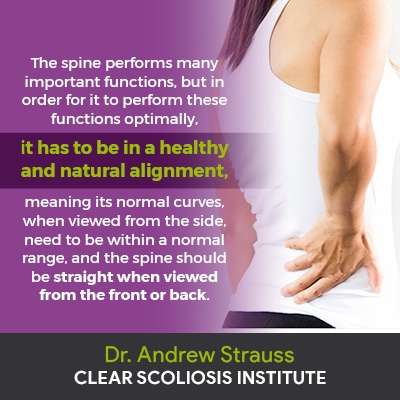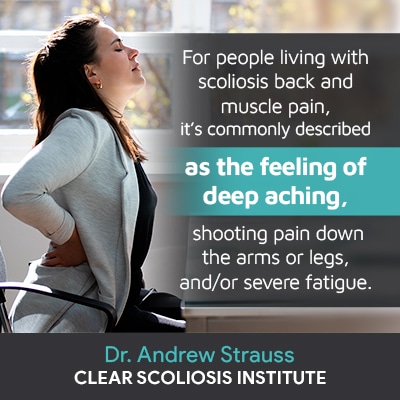
There are multiple factors that go into determining the type of symptoms a person’s scoliosis is likely to produce. Patient age, amount of degeneration in the spinal joints, curvature location, and posture changes all play a role. Interestingly, there is no correlation between curve size and the amount of pain produced by the scoliosis; people with small curves can experience strong pain and people with large curves may have little or no pain.
Scoliosis is a highly variable spinal condition, meaning every case is different. Scoliosis is not generally known as painful in children and adolescents, but adults experience scoliosis-related pain very differently; this is due to how compression is felt by the spine and its surroundings.
Before moving on to the specific topic of how scoliosis is linked with pain, let’s first take a general look at what defines the condition, in addition to what is happening inside the body of a person with scoliosis.
When a person develops scoliosis, this means they have an abnormal sideways curvature of the spine, with rotation, or twisting of the spinal bones.
In addition, an abnormal spinal curvature has to have a minimum Cobb angle measurement of 10 degrees to be diagnosed as scoliosis.
The spine gives the body structure and support, allowing us to practice good posture and remain upright. In addition, the spine protects the spinal cord, which resides within the spine. The delicate spinal cord works in tandem with the brain to form the body’s central nervous system (CNS).
The spine, when viewed from the side, has natural curves for multiple reasons: it gives it added strength, flexibility, and allows for the even distribution of mechanical stress that occurs during movement.

Once one or more of the spine’s healthy normal curves are lost, or abnormal spinal curvature (scoliosis) develops, the spine becomes more and more stressed by gravity and normal movements due to disruptions to the biomechanics of the entire spine.
As the spine is the essential protection of the spinal cord, conditions like scoliosis can cause a number of potential side effects felt throughout the body, including a variety of types and locations of pain, especially if incorrectly treated.
To fully explore the topic of scoliosis-related pain, we need to first address a couple of key patient/condition characteristics, as these can help shape a person’s experience of life with the condition: patient age and the amount of postural changes resulting from the scoliosis.
When a person is diagnosed with scoliosis, the condition is further classified based on a number of important factors: patient age, the amount of degenerative changes to the spinal joints, age that the scoliosis was identified, curvature location, and size of the curve.
These variables help in crafting an effective and customized treatment plan, as the very nature of scoliosis necessitates an integrative and customized treatment approach. Every scoliosis is different, and each patient requires a unique plan of care.
While every case is different and the aforementioned factors can all play a role in determining how painful a condition is, generally speaking, the most important pain-related variables are patient age, the extent of the degenerative changes, and severity of postural changes.
As mentioned, scoliosis is not commonly known as painful in children and adolescents, but in adults, the experience of scoliosis-related pain is very different.
Not only can scoliosis develop at any age, there are also multiple types that can develop, and the condition’s most prevalent form in children is termed ‘idiopathic’, meaning there is no single-known cause. In adults over 50 years old, we see either childhood idiopathic scoliosis in the adult, or more commonly, adult degenerative scoliosis, also known as ‘denovo scoliosis’.
Idiopathic scoliosis accounts for 80 percent of known diagnosed cases in children, the most common form being adolescent idiopathic scoliosis (AIS), diagnosed between the ages of 10 and 18, while the remaining 20 percent are infantile and juvenile forms that begin earlier in life. More rare forms of scoliosis are associated with known causes: birth defects, specific medical syndromes like Marfan’s, neuromuscular conditions like cerebral palsy, and traumatic injury.
For our current purposes of exploring how scoliosis is linked with pain, we will focus on 2 specific types of scoliosis: ASA (adolescent scoliosis in adults) and denovo (adult degenerative scoliosis), as these forms are the most prevalent and illustrate how scoliosis-related pain tends to differ in adults.
Adolescent Idiopathic Scoliosis in Adults
The most dangerous time for rapid progression of scoliosis is in young patients who are still growing. In children and adolescents, it is best to begin treatment when the curves are mild. Unfortunately, mild curves are often not picked up by parents, school nurses or pediatricians, and smaller curves are much easier to manage than larger curves.
While every case is different, if the curve is small, scoliosis doesn’t generally produce noticeable functional deficits and will only show mild postural changes.
In addition, as scoliosis isn’t commonly painful for young people, it can be difficult for an average person to notice the condition’s early signs, which is why it so often remains undiagnosed until after it’s progressed in severity, or even until after skeletal maturity has been reached.
Degenerative Adult Scoliosis
Adult patients reach skeletal maturity between 18 and 21 years old; at this point, the spine is no longer growing, but is still vulnerable to various physical stresses and the compression of gravity felt by the spine and its surrounding ligaments, muscles, and nerves. In fact, it’s most commonly the pain associated with scoliosis that brings adults in for a diagnosis and treatment.
The two main forms of scoliosis in adults are idiopathic and degenerative. Adults with idiopathic scoliosis are cases of AIS that progressed into maturity; this is common as the condition’s effects tend to become more noticeable, especially in terms of pain, once skeletal maturity has been reached.
In addition, adults also face natural degenerative changes associated with aging, including the spine, which can lead to the development of degenerative scoliosis.
The presence of other spinal conditions, such as osteoarthritis and osteoporosis, that weaken the spinal bones and the associated ligaments can also lead to the development of degenerative scoliosis. When more significant postural distortion impacts the spine adversely, scoliosis can be more severe, progressive, and/or painful.
As you can see, when it comes to compression-related pain, this is far more commonly a part of the adult experience of scoliosis, than the typical child and teenage experience.
As previously mentioned, curve size is not a reliable predictor when determining the type of likely symptoms a person will experience. Yes! A large curve may have little to no pain associated with it and a smaller curve may provoke strong pain.
Scoliosis is a highly-variable condition, meaning it can range greatly in severity from one patient to the next.
When scoliosis is diagnosed, part of the process of diagnosis and assessment involves taking a measurement, via X-ray, known as Cobb angle.
Mild scoliosis: Cobb angle measurement of between 10 and 25 degrees
Moderate scoliosis: Cobb angle measurement of between 25 and 40 degrees
Severe scoliosis: Cobb angle measurement of 40+ degrees
This measurement is important because it tells us how far out of alignment a scoliotic spine is, but a more reliable predictor of pain will be the extent of postural distortion which can be independent of the degree of Cobb angle. Posture is evaluated by X-ray along with digital photography where the postural changes can be measured and compared.
Degenerative scoliosis in adults is progressive, this means it’s in its very nature to worsen over time, if left untreated.
While we don’t fully understand the underlying causes of idiopathic scoliosis, we do understand what triggers its progression: growth in children, and degenerative changes in adults. Adolescents and teens entering into, or who are already in, the stages of puberty are at risk for rapid progression due to the unpredictable growth spurts they are facing. Rapid growth = increased chances of rapid curve progression.
As a condition progresses in severity, this means the curvature is getting larger, and the related postural changes it causes tend to also increase, becoming more noticeable, along with other related symptoms like muscle tension, aching, fatigue and even reduced lung function.
As scoliosis introduces a lot of uneven forces to the body, these uneven forces can result in postural deviation that causes a shift in the body’s overall symmetry, and the condition’s overall asymmetrical effect is linked to varying levels of back, joint, and muscle pain.
Most commonly, the overall asymmetrical effect that scoliosis has on the body is related to postural changes affecting the shoulders, shoulder blades, waist, hips, and a visibly-curved spine.
Remember, it’s not just the spine itself that’s charged with maintaining its natural alignment and curvatures, but also the spine’s surrounding ligaments and musculature that helps provide it with support and stabilization.
An abnormally-curved spine means the body’s overall positioning and posture is disrupted, and this means the body’s related joints and muscles are not being worked evenly. Muscles and ligaments that surround the spine are being exposed to adverse tension as they struggle to support a scoliotic spine and account for related postural shifts.
So in addition to general back pain, scoliosis also has the potential to cause related muscle and nerve pain due to compression and/or adverse tension and uneven wear.
In adolescents, an estimated 20 percent report some issues with scoliosis-related muscle pain. Again, adults are more likely to experience back and radiating nerve pain, plus related muscle pain, as a result of their age, condition severity, and the effects of spinal degeneration associated with aging.
In adults with scoliosis, the normal aging process causes a loss of height of the spinal cushions or discs. This loss of height allows the ligaments supporting the spine to become slack allowing the spinal bones to twist and slide into a scoliosis. In adults over the age of 60, research shows that scoliosis affects 60% of the population!
Now that we have touched on the main patient and condition variables that play a role in determining how painful a person’s scoliosis is, let’s say a few general words about scoliosis pain, including how people living with scoliosis describe that pain.
Scoliosis pain can be felt in the back, the muscles surrounding the back, and also pain radiating to other areas of the body, particularly if nerve compression is involved.
As mentioned, feeling the effects of compression isn’t a common issue for young patients, but for adults, nerve-related pain down the arms and legs, and pain felt especially in the lower and middle back, can range from mild to debilitating.
Related: Scoliosis & Hip Pain
Nerves are like branches on a tree, fanning off in multiple directions. If an abnormal spinal curvature is compressing a nerve, related pain can be felt far from its site of origin. In addition to back pain, it’s common for adults to complain of related muscle pain, in addition to radiating pain and numbness felt in the legs and feet.
Curvature location can also play a role in pain location, as a curvature of the cervical spine (neck), for example, is more likely to produce pain in the upper back, shoulders, arms, and neck, not to mention potential lower back pain as the result of developing a secondary curve.

In addition, scoliosis does also have the potential to cause painful headaches, some reaching migraine status, due to nerve pressure and/or muscle spasms.
For people living with scoliosis back and muscle pain, it’s commonly described as the feeling of deep aching, shooting pain down the arms or legs, and/or severe fatigue. Scoliosis patients also describe feelings of stiffness and tightness in the back, muscles, and other areas of the body that are affected, such as the pelvis and hips.
So does scoliosis cause pain? It most certainly can, but every case is different and will depend on multiple factors, such as patient age and condition severity.
In general, scoliosis is not commonly described as painful in children and adolescents; adults, however, are vulnerable to the curvature’s compressive force and can experience varying levels of back and muscle pain related to age, compression, posture and severity.
When it comes to pain management and scoliosis, the best approach is proactive treatment that addresses the true structural nature of the condition. Smaller curves are easier to treat than larger curves, so don’t wait! Seek care early.
There is a big difference between addressing scoliosis-related pain, or treating the underlying cause of that pain: the condition itself.
Here at the CLEAR Scoliosis Institute, we offer patients customized scoliosis-specific exercises, therapy, and chiropractic alignment treatments that synergistically work towards pain reduction, postural correction, curve stabilization, and in many cases, curvature reductions.
Clear-institute.org - Cobb Angle
Clear-institute.org - What Causes Scoliosis?
Clear-institute.org - Scoliosis Side Effects: Myth vs. Reality
Clear-institute.org - Degenerative Scoliosis
Scoliosisresearchsociety.com - Adolescent Idiopathic Scoliosis

CLEAR provides a unique and innovative way of understanding scoliosis. Sign up to receive facts and information you won’t find anywhere else.
